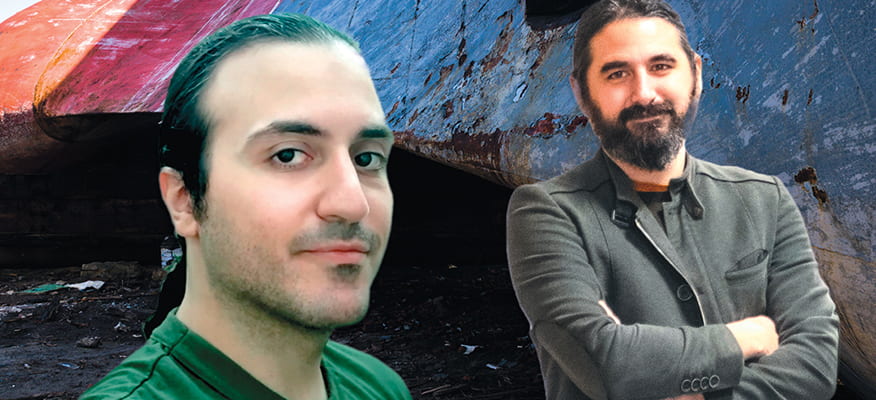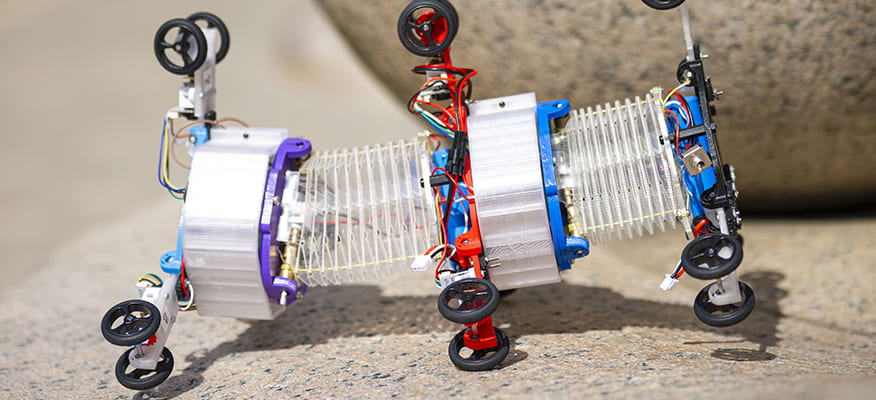Aiming High
Pioneering fighter pilot Stacey Cotton Bonasso '90 inspires the next generation as a high school STEM teacher.
Read StoryAs WPI researchers—and alumni—introduce innovative robotic solutions into entirely new workplace environments, understanding how humans interact, appreciate, and accept these high-tech coworkers takes on greater significance in the quest to harness the strengths of both.
Thanks to a National Science Foundation-funded training grant, a community of researchers within the Department of Robotics Engineering is focusing on this human element, overlaying WPI’s distinctive holistic approach to putting theory into practice.
In the stories that follow, read how robots are working alongside humans to reinforce the skills of physical therapists, explore inaccessible areas, complete tedious and physically demanding work, and shoulder dangerous tasks—real-life examples of how robots are essential tools in a high-tech, hybrid workplace of the future.
A National Science Foundation-funded training program has helped graduate student researchers think holistically about how humans interact with robots in the workplace, while also providing them with mentoring and career advice. The Future of Robots in the Workplace-Research and Development (FORW-RD) program also created a much-needed community of like-minded graduate students, a community that faculty hope can continue even after the five-year, $3-million NSF grant ends.
The grant came about after principal investigator Cagdas Onal, associate professor in the Department of Robotics Engineering, and Yunus Telliel, assistant professor of humanities and arts and co-PI, talked informally about the intersection of their work: How robotic technology can be integrated in the workplace in a socially responsible way, and how humans respond to such technology in the workplace.
In 2019, they applied for and received a grant from NSF’s Research Traineeship (NRT) program, which that year awarded $49 million to 17 institutions across the United States to develop and implement graduate education traineeship models in STEM fields. Since then, 47 trainees—half of whom are international students—have joined the program, with 21 receiving fellowships that include a stipend, tuition, and health insurance. While the grant expires this year, the hope is that the structure can continue using institutional funds or other grants.
In addition to career help and mentoring, FORW-RD trainees participate in specific courses, idea-exchanging seminars, and soft skill development seminars. They also can connect with industry partners, including the five members of the program’s advisory board: Heather Cheong of BD AI Institute, Zachary Dydek of Vecna Robotics, Greg Longtine of Amazon Robotics, Nicole Neves of iRobot, and Victor Puksta of Meta. Each trainee is also expected to complete a thesis/dissertation that includes an aspect of human-robot interfacing in the workplace.
“It started as a funding mechanism, but it’s no longer just that,” says Kristen Keane, NRT program coordinator. Participants continue to be involved in the community even after their funded year, mentoring new trainees and remaining involved in career development and social activities.
Other co-principal investigators include Jing Xiao, professor and head of the Department of Robotics Engineering; Jane Li, assistant professor of robotic engineering; and Pratap Rao, associate professor of mechanical engineering. Other faculty participating include Soussan Djamasbi, professor of information systems in The Business School; Jeanine Skorinko, professor of psychology and director of the Psychological Science Program; Berk Calli, assistant professor of robotics engineering; Carlo Pinciroli, associate professor of robotics engineering; Erin Solovey, associate professor of computer science; and Loris Fichera, assistant professor of robotics engineering.

Tess Meier uses an insider’s perspective to perfect an exoskeleton hand prototype.

Assistant Professor Berk Calli and student researchers work to create a robot to safely break up ships.

Associate Professor Cagdas Onal leads research perfecting lizard-like robots that sneak into small spaces for mapping and inspections.

Derrick Morse ’01, MS ’03, cofounded Rugged Robotics to tackle the back-breaking, detailed work of layout transfer.

ROSE-HUB bridges the gap between WPI robotics research and the development of commercial technologies.
“In my view, the FORW-RD program is a living testimony to how cross-disciplinary collaboration leads to communal growth,” says James Akl, PhD ’23, a former trainee. “The program’s overall structure, the relationships, and the community aspect have been real treasures. Without FORW-RD, my PhD path would have been a much lonelier and isolated path.”
“I have learned from FORW-RD that while robotics can be a source of world-changing innovation, we cannot move forward without thinking of the societal, economic, and political impacts of the technology,” says Raagini Rameshwar, PhD ’23. “The FORW-RD program has also provided an invaluable source of community within the WPI graduate program. The cohort is a diverse set of students and together we learn about robotics, social and ethical issues in technology, the world, and ourselves.”
Reader Comments
0 Comments